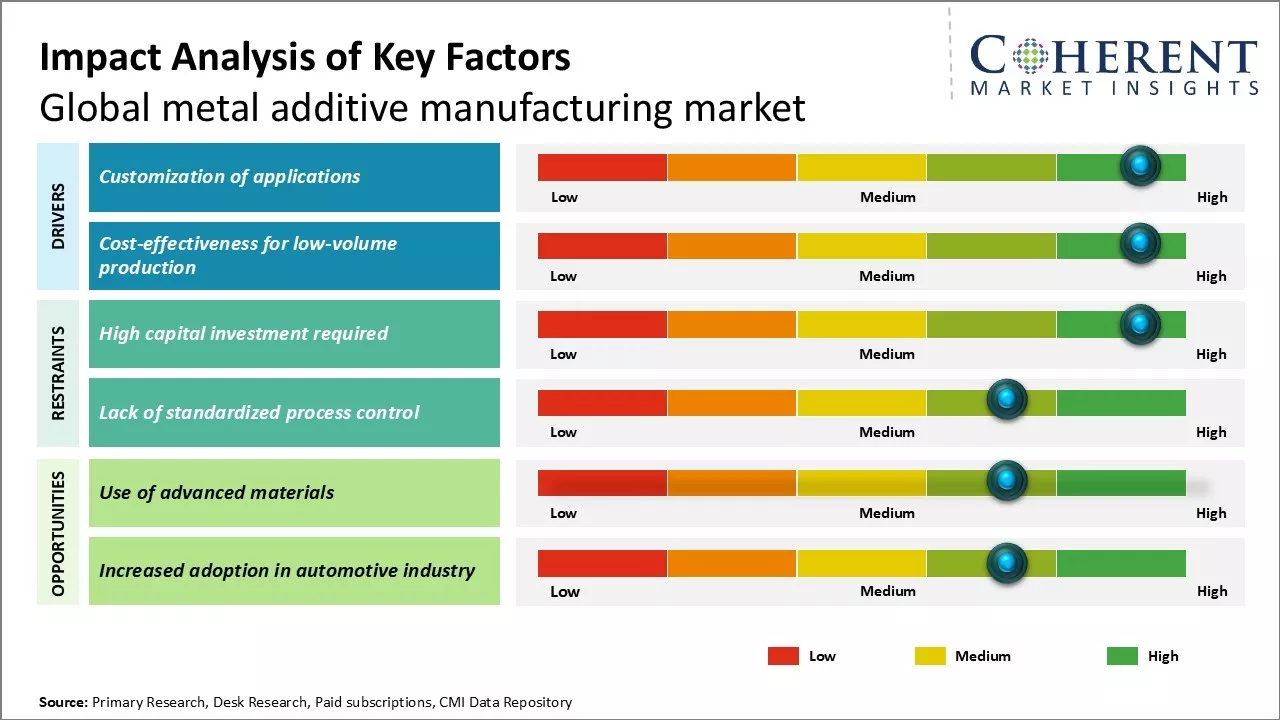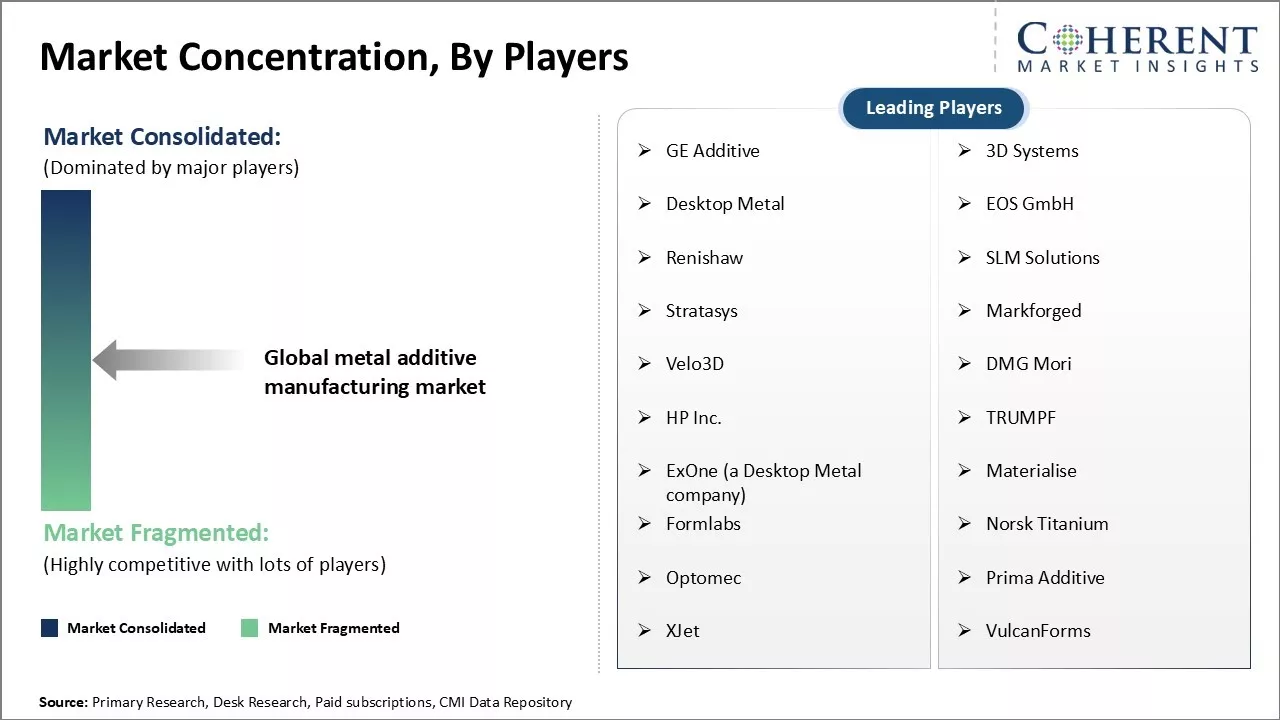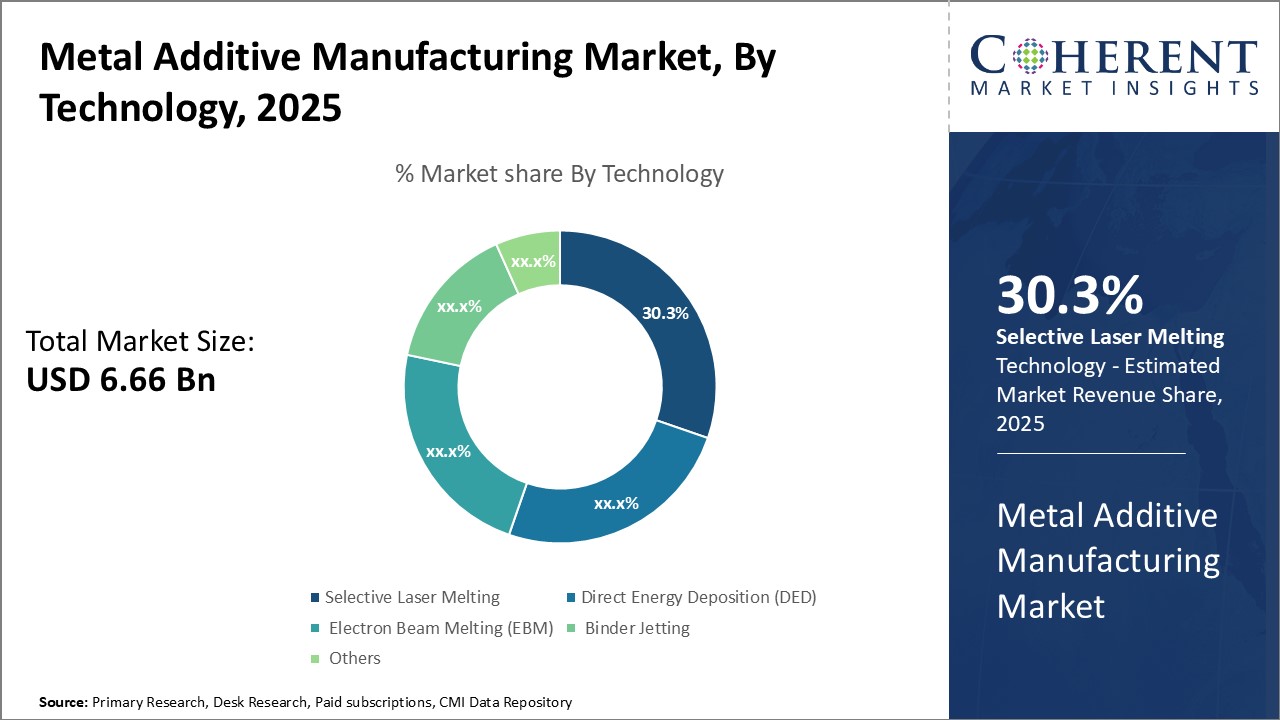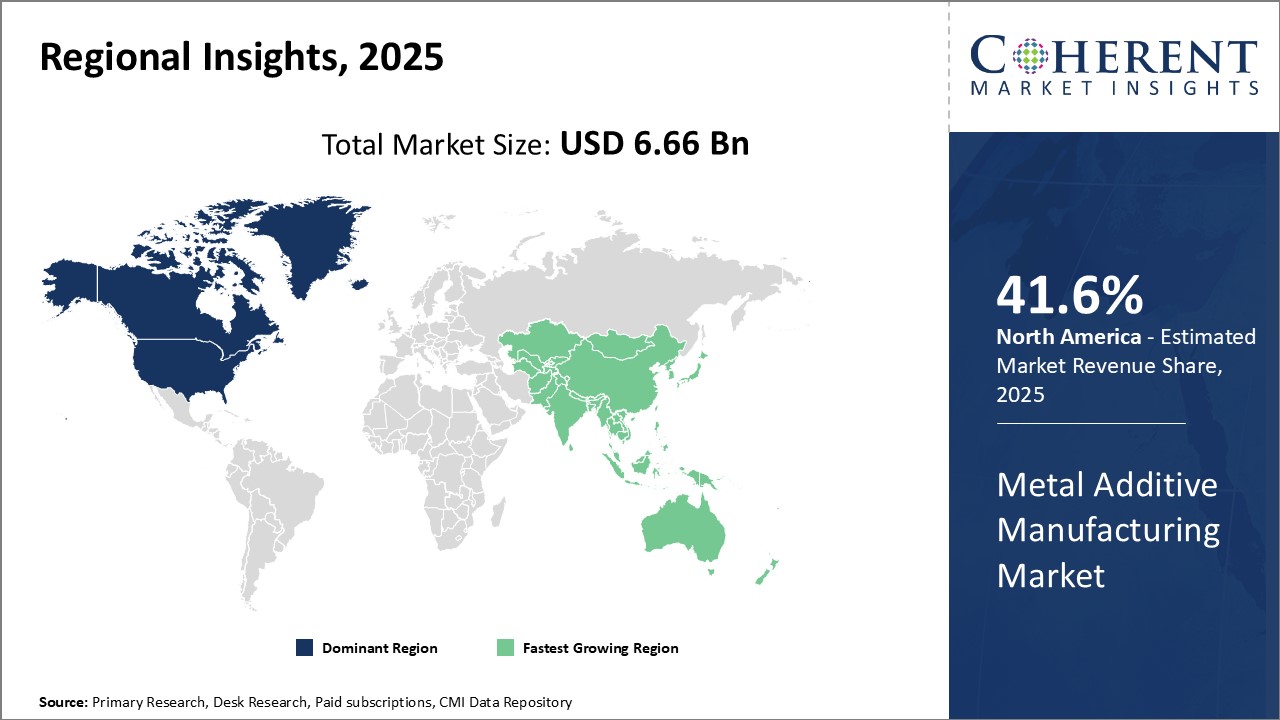Metal Additive Manufacturing Market Size and Trends
Global metal additive manufacturing market is estimated to be valued at USD 6.66 Bn in 2025 and is expected to reach USD 16.58 Bn by 2032, exhibiting a compound annual growth rate (CAGR) of 13.9% from 2025 to 2032.

Discover market dynamics shaping the industry: Download Free Sample
Global metal additive manufacturing market growth is driven by increasing demand from the automotive industry for additive manufacturing of complex parts and a reduction in production costs. Adoption of 3D printing for rapid prototyping and increasing focus on personalized healthcare can also boost demand. Ongoing research and development activities to expand the application scope along with the capability to produce intricate design parts, not possible through conventional methods, can provide opportunities for market growth in the near future. However, high capital requirement for equipment and lack of standard processes can hamper the market growth.
Customization of applications
Additive manufacturing enables the customization of applications in manufacturing industry. With additive processes, manufacturers can produce complex parts and products with intricate internal features, moving parts, optimized lattices and lightweight designs, which were simply not possible with traditional machining or molding. These also have capability produce fully customized designs on demand for each customer without having to produce bulk inventory. This offer tremendous value to customers who need specially designed solution for their unique application or requirements.
Now designers have freedom to design without limitation of machinability or molding constraints. These can configure complex internal cooling channels in metal parts, put customized logo or designs on products and create complex geometries optimized for strength or other performance parameters. Recently an example where a manufacturer of off-road vehicles was able to produce suspension joints of customized design for each vehicle depending on its intended application of rough terrain racing or long-distance Rally. Previously these manufacturers had to produce standard design with some compromises to cater to both types of vehicles but with additive manufacturing these could tune the suspension for precise needs.
Even in production of replacement parts, additive manufacturing allows customized configuration. A tool and die factory had problem with frequent breakdown of particular machine part which required long downtime for replacements to be shipped from overseas. With metal additive technology inhouse, these are now able to scan the damaged part, modify the design as needed and print customized replacement part within a day to minimize disruption.
Market Concentration and Competitive Landscape

Get actionable strategies to beat competition: Download Free Sample
Cost-effectiveness for low-volume production
Competitive advantage of metal additive manufacturing for production of low volume parts with complex designs can drive the market growth. While traditional methods of machining or molding require high set-up costs and long lead times for non-standard parts, additive processes have much lower incremental costs for additional parts. Once the initial file preparation is done, additional parts can be printed with relatively lower material and time costs involved. This makes additive manufacturing highly cost effective for prototype development and low-rate initial production where very few parts may be needed.
An aerospace components OEM assessed production of minor spare part which was needed occasionally when older aircraft went through routine maintenance check. With traditional methods, the small production volumes did not justify investments in tooling or setup. With metal 3D printing, these were able to produce these customized parts on demand without minimum order quantities or shelf-life issues of pre-produced inventory. Similarly, medical device companies routinely use additive processes to produce surgical guides, dental moldings or customized implants based on patients CT/MRI scans. Provided each patient's anatomy is unique, conventional production becomes too costly.
Many industrial equipment manufacturers have transitioned from refurbishing old components to additive repair or replacement due to cost benefits. Rather than warehousing inventory of standardized parts, printers can now be setup on-site or near field service centers to print any customized parts when needed. Overall total ownership cost reduces significantly especially when transportation or inventory carrying costs are high for infrequently needed specialty parts.
Additive manufacturing allows traversing the learning curve much faster for new complex product development when iterations are needed. Limited production runs for testing designs or new materials become feasible as compared to conventional tooling. Effectively it lowers the barriers for low volume specialized component manufacturing.
Key Takeaways from Analyst:
Global metal additive manufacturing market growth is driven by increasing demand from industries such as aerospace, automotive and healthcare. The ability of metal 3D printing technologies to produce complex geometries and reduce lead times can boost their adoption across manufacturing sectors. Furthermore, the cost benefits of metal additive manufacturing over traditional techniques can boost its usage for low volume production applications.
High material and equipment costs can act as restraint for metal 3D printing. The market also faces challenges in the development of standard processes and quality control protocols. Sustainability concerns around powder recycling can hamper the market growth.
North America currently dominates the market due to presence of major players and rapid technology advancement. Increasing investments by governments and companies for the development of novel materials can offer growth opportunities in the region. Asia Pacific is expected to witness fastest growth due to rising automation adoption in China and government initiatives to promote additive technologies in countries like India. In Europe, growth impetus stems from ongoing research for application diversification across industries.
Continued partnerships between private players and research organizations as well as development of powders like Inconel and titanium alloys can drive the market growth. Wider accessibility of metal 3D printing drives can encourage adoption among small businesses and individual users.
Market Challenges: High capital investment required
Global metal additive manufacturing market growth can be hampered due to high capital investment required to establish additive manufacturing facilities. Setting up industrial-grade 3D metal printers, supporting metal powder production processes, and compulsory safety certifications involve massive initial costs. While hardware prices are declining year-over-year, a commercial-scale production system can also be expensive. This prohibitive expense prevents many smaller manufacturers from adopting the technology in their operations. Maintaining and upgrading such advanced manufacturing equipment throughout its lifespan demands continued capital allocation. The high barrier to entry protects larger enterprises from competition but slows the overall diffusion of metal additive manufacturing across different sectors. To address this issue, industry participants are exploring shared services models and pay-per-use arrangements to help minimize upfront capital outlays for interested parties.
Market Opportunities: Use of advanced materials for market
Usage of advanced materials can offer growth opportunities for global metal additive manufacturing market. As the technology matures, it gains capabilities to 3D print increasingly complex metal alloys with tailored microstructures and properties. Materials like titanium and nickel alloys that were previously difficult to produce through traditional methods can be precisely deposited layer-by-layer. This allows the development of new materials optimized for strength, lightweight, corrosion resistance and other performance attributes. It also facilitates on-demand production of scarce or expensive alloys. Many industries, including aerospace, medical and energy, are actively pursuing novel materials to develop radical new product designs. The precision of additive processes enables designers to leverage unique material combinations at micron-level resolutions. This drives innovation and increases applications of advanced materials across multiple end-use sectors. It can create new revenue streams and drive the market growth in the future.

Discover high revenue pocket segments and roadmap to it: Download Free Sample
Insights, By Technology: Precision and versatility drive segment growth
In terms of technology, selective laser melting (SLM) segment is estimated to contribute the highest market share of 30.3% in 2025, owing to its precision and versatility.
Selective laser melting (SLM) technology has emerged as the dominant process in metal additive manufacturing due to its ability to produce highly complex parts with precision. SLM allows manufacturers to 3D print metal components layer by layer directly from digital models, offering unparalleled design flexibility compared to traditional methods. This precise layer-by-layer melting using a high-power laser allows creation of complex geometries that would be nearly impossible to manufacture through conventional machining or casting techniques.
SLM’s versatility enables on-demand production of low-volume customized parts, without the costs associated with tooling or setup for conventional production methods. It is well-suited for industries like aerospace and medical where high strength, complex lightweight structures are essential. SLM is also used in automotive and industrial equipment sectors for making application-specific components. The technology’s design freedom allows optimization of part performance by adding features like functional lattices or internal cooling channels that were not feasible before. SLM continues to lead the metal additive manufacturing industry, owing to its unique advantages over other technologies for producing intricate, application-engineered metal components.
Insights, By Application: Regulatory acceptance and design optimization opportunities
In terms of application, aerospace segment is estimated to contribute the highest market share of 34.5 in 2025, due to regulatory acceptance and design optimization opportunities. The aerospace sector has emerged as the largest application industry for metal additive manufacturing due to immense opportunities as well as regulatory acceptance for critical structural 3D printed aircraft parts. Metal 3D printing allows creation of net-shape components and complex interior geometries that result in lighter aircraft structures while maintaining integrity. This translates to better fuel efficiency and longer ranges. Regulatory bodies like FAA and EASA have now approved selective laser melting printed parts for installation in aircraft that is used for commercial passenger transportation.
Aerospace manufacturers are leveraging metal additive manufacturing technologies to optimize aircraft designs. Intricate features like hollow lattice structures further reduce weight while retaining strength. Internal cooling channels cast into 3D printed parts improves heat management and durability. Metal 3D printing also aids prototyping of next-generation designs involving integral complexity. With an increasing focus on sustainability and lower life cycle costs in aviation, additive technologies play a vital role in design optimization and production of more efficient aircraft.
Regional Insights

Need a Different Region or Segment? Download Free Sample
North America has established itself as the dominant region in the global metal additive manufacturing market with an estimated market share of 41.6% in 2025. The country is home to several well-established industry leaders with huge R&D budgets and manufacturing infrastructure dedicated to this technology. Major aerospace and defense firms like Boeing, Lockheed Martin and GE Aviation have significantly invested in metal 3D printing for developing complex parts for their products. With booming aerospace sector driving demand, the U.S. accounts for the largest share of metal 3D printed parts used in production globally.
The automotive industry is also a major adopter of additive manufacturing technologies in the U.S. Ford, GM and Tesla are pioneering the use of 3D printing for low volume production parts as well as prototypes. These leverage the technology for developing lightweight structures and complex designs that can improve performance. The strong presence of advanced manufacturing is complementing metal 3D printing adoption across various industrial sectors such as energy and healthcare as well. Thriving startup culture has led to numerous small businesses commercializing metal printing solutions.
Asia Pacific has emerged as the fastest growing regional market for metal additive manufacturing. It aims to be a global leader in advanced manufacturing through initiatives like 'Made in China 2025'. The Chinese government is providing significant funding and tax incentives to drive adoption of 3D printing technologies. Several state-run research institutes are collaborating with leading global players to develop core and powder bed fusion systems suitable for high-volume production. Local manufacturers are additionally gaining expertise in design and production of 3D printing equipment as well as metal powders.
The Chinese aerospace industry, in particular, has outlined ambitious plans for reducing foreign dependency that involve ramping up metal 3D printing programs. Other industries like electronics, tools and dies are increasingly turning to metal printing to develop personalized or low-volume components. China also has a thriving machine tools industry catering to global demand which provides opportunities to supply specialized 3D printers to them. Its strategic moves towards self-sufficiency makes China an attractive regional market to tap into the fast growth of metal additive manufacturing.
Market Report Scope
Metal Additive Manufacturing Market Report Coverage
| Report Coverage | Details | ||
|---|---|---|---|
| Base Year: | 2024 | Market Size in 2025: | USD 6.66 Bn |
| Historical Data for: | 2020 To 2024 | Forecast Period: | 2025 To 2032 |
| Forecast Period 2025 to 2032 CAGR: | 13.9% | 2032 Value Projection: | USD 16.58 Bn |
| Geographies covered: |
|
||
| Segments covered: |
|
||
| Companies covered: |
GE Additive, 3D Systems, Desktop Metal, EOS GmbH, Renishaw, SLM Solutions, Stratasys, Markforged, Velo3D, DMG Mori, HP Inc., TRUMPF, ExOne (a Desktop Metal company), Materialise, Formlabs, Norsk Titanium, Optomec, Prima Additive, XJet, and VulcanForms |
||
| Growth Drivers: |
|
||
| Restraints & Challenges: |
|
||
Uncover macros and micros vetted on 75+ parameters: Get instant access to report
Metal Additive Manufacturing Industry News
- In June 2024, Additive Industries, a leading Netherlands-based company in the field of additive manufacturing, launched the latest iteration of its flagship MetalFab 3D printing technology at the RAPID + TCT event. The new MetalFab 300 Flex model introduces unprecedented flexibility for manufacturers, setting a new standard in the 3D printing industry with its innovative on-demand build platform size, which is believed to be an industry first.
- In 2023, 3D Systems, Inc. announced the launch of NextDent Cast and NextDent Base, two innovative printing materials, alongside the NextDent LCD1, a user-friendly small-format printing platform. These new offerings are designed to enhance material properties and simplify the additive manufacturing process, supporting customers in their transition to advanced 3D printing technologies.
- In 2023, Autodesk Inc., a global leader in design and engineering software, announced the launch of Autodesk AI, a groundbreaking technology that aims to revolutionize the way customers interact with Autodesk products. This new AI-powered solution is designed to provide users with generative capabilities and intelligent assistance, streamlining workflows and enhancing productivity across various industries.
- In 2022, Dassault Systèmes, a global leader in 3D design and engineering software, announced a strategic partnership with Cadence Design Systems, Inc. This partnership aims to deliver integrated solutions that facilitate the development of high-performance electronic systems for enterprise customers across various vertical markets, including high tech, industrial equipment, transportation and mobility, aerospace and defense, and healthcare.
*Definition: Global metal additive manufacturing market involves the production of metal parts and components using 3D printing or additive manufacturing technologies like laser powder bed fusion, directed energy deposition, and binder jetting. It allows manufacturers to create complex metal designs that would be difficult or impossible to produce with traditional machining. The metal parts can be made out of various materials like titanium, aluminum, stainless steel, and nickel alloys.
Market Segmentation
- By Technology Insights (Revenue, USD Bn, 2020 - 2032)
-
- Selective Laser Melting (SLM)
- Direct Energy Deposition (DED)
- Electron Beam Melting (EBM)
- Binder Jetting
- Others
- By Application Insights (Revenue, USD Bn, 2020 - 2032)
-
- Aerospace
- Automotive
- Healthcare
- Industrial Equipment
- Others
- By Regional Insights (Revenue, USD Bn, 2020 - 2032)
-
- North America
- U.S.
- Canada
- Latin America
- Brazil
- Argentina
- Mexico
- Rest of Latin America
- Europe
- Germany
- U.K.
- Spain
- France
- Italy
- Russia
- Rest of Europe
- Asia Pacific
- China
- India
- Japan
- Australia
- South Korea
- ASEAN
- Rest of Asia Pacific
- Middle East
- GCC Countries
- Israel
- Rest of Middle East
- Africa
- South Africa
- North Africa
- Central Africa
- North America
- Key Players Insights
-
- GE Additive
- 3D Systems
- Desktop Metal
- EOS GmbH
- Renishaw
- SLM Solutions
- Stratasys
- Markforged
- Velo3D
- DMG Mori
- HP Inc.
- TRUMPF
- ExOne (a Desktop Metal company)
- Materialise
- Formlabs
- Norsk Titanium
- Optomec
- Prima Additive
- XJet
- VulcanForms
Share
Share
About Author
Yash Doshi is a Senior Management Consultant. He has 12+ years of experience in conducting research and handling consulting projects across verticals in APAC, EMEA, and the Americas.
He brings strong acumen in helping chemical companies navigate complex challenges and identify growth opportunities. He has deep expertise across the chemicals value chain, including commodity, specialty and fine chemicals, plastics and polymers, and petrochemicals. Yash is a sought-after speaker at industry conferences and contributes to various publications on topics related commodity, specialty and fine chemicals, plastics and polymers, and petrochemicals.
Missing comfort of reading report in your local language? Find your preferred language :
Transform your Strategy with Exclusive Trending Reports :
Frequently Asked Questions
EXISTING CLIENTELE
Joining thousands of companies around the world committed to making the Excellent Business Solutions.
View All Our Clients
